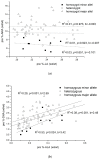Determinants of Plasma Docosahexaenoic Acid Levels and Their Relationship to Neurological and Cognitive Functions in PKU Patients: A Double Blind Randomized Supplementation Study
- PMID: 30544518
- PMCID: PMC6316534
- DOI: 10.3390/nu10121944
Determinants of Plasma Docosahexaenoic Acid Levels and Their Relationship to Neurological and Cognitive Functions in PKU Patients: A Double Blind Randomized Supplementation Study
Abstract
Children with phenylketonuria (PKU) follow a protein restricted diet with negligible amounts of docosahexaenoic acid (DHA). Low DHA intakes might explain subtle neurological deficits in PKU. We studied whether a DHA supply modified plasma DHA and neurological and intellectual functioning in PKU. In a double-blind multicentric trial, 109 PKU patients were randomized to DHA doses from 0 to 7 mg/kg&day for six months. Before and after supplementation, we determined plasma fatty acid concentrations, latencies of visually evoked potentials, fine and gross motor behavior, and IQ. Fatty acid desaturase genotypes were also determined. DHA supplementation increased plasma glycerophospholipid DHA proportional to dose by 0.4% DHA per 1 mg intake/kg bodyweight. Functional outcomes were not associated with DHA status before and after intervention and remained unchanged by supplementation. Genotypes were associated with plasma arachidonic acid levels and, if considered together with the levels of the precursor alpha-linolenic acid, also with DHA. Functional outcomes and supplementation effects were not significantly associated with genotype. DHA intakes up to 7 mg/kg did not improve neurological functions in PKU children. Nervous tissues may be less prone to low DHA levels after infancy, or higher doses might be required to impact neurological functions. In situations of minimal dietary DHA, endogenous synthesis of DHA from alpha-linolenic acid could relevantly contribute to DHA status.
Keywords: cognitive function; docosahexaenoic acid; motor skills; neurological function; phenylketonuria.
Conflict of interest statement
The authors declare no conflict of interest. The funders had no role in the design of the study; in the collection, analyses, or interpretation of data; in the writing of the manuscript, and in the decision to publish the results.
Figures





Similar articles
-
Omega-3 LC-PUFA supply and neurological outcomes in children with phenylketonuria (PKU).J Pediatr Gastroenterol Nutr. 2009 Mar;48 Suppl 1:S2-7. doi: 10.1097/MPG.0b013e3181977399. J Pediatr Gastroenterol Nutr. 2009. PMID: 19214054 Review.
-
Does dietary DHA improve neural function in children? Observations in phenylketonuria.Prostaglandins Leukot Essent Fatty Acids. 2009 Aug-Sep;81(2-3):159-64. doi: 10.1016/j.plefa.2009.06.006. Epub 2009 Jul 16. Prostaglandins Leukot Essent Fatty Acids. 2009. PMID: 19615874
-
[Neurological, neuropsychological, and ophthalmological evolution after one year of docosahexaenoic acid supplementation in phenylketonuric patients].Rev Neurol. 2012 Aug 16;55(4):200-6. Rev Neurol. 2012. PMID: 22829083 Clinical Trial. Spanish.
-
Effects of LC-PUFA Supplementation in Patients with Phenylketonuria: A Systematic Review of Controlled Trials.Nutrients. 2019 Jul 6;11(7):1537. doi: 10.3390/nu11071537. Nutrients. 2019. PMID: 31284588 Free PMC article.
-
Supplementation with a powdered blend of PUFAs normalizes DHA and AA levels in patients with PKU.Mol Genet Metab. 2013 Jun;109(2):121-4. doi: 10.1016/j.ymgme.2013.03.006. Epub 2013 Mar 21. Mol Genet Metab. 2013. PMID: 23562298
Cited by
-
Perinatal Polyunsaturated Fatty Acid Status and Obesity Risk.Nutrients. 2021 Oct 29;13(11):3882. doi: 10.3390/nu13113882. Nutrients. 2021. PMID: 34836138 Free PMC article. Review.
-
Long-Chain Polyunsaturated Fatty Acids Effects on Cardiovascular Risk in Childhood: A Narrative Review.Nutrients. 2023 Mar 29;15(7):1661. doi: 10.3390/nu15071661. Nutrients. 2023. PMID: 37049503 Free PMC article. Review.
-
Beyond Nutrient Deficiency-Opportunities to Improve Nutritional Status and Promote Health Modernizing DRIs and Supplementation Recommendations.Nutrients. 2021 May 28;13(6):1844. doi: 10.3390/nu13061844. Nutrients. 2021. PMID: 34071268 Free PMC article. Review.
-
A Systematic Review of Omega-3 Fatty Acid Consumption and Cognitive Outcomes in Neurodevelopment.Am J Lifestyle Med. 2022 Nov 16;17(5):649-685. doi: 10.1177/15598276221116052. eCollection 2023 Sep-Oct. Am J Lifestyle Med. 2022. PMID: 37711355 Free PMC article. Review.
-
Effect of Omega-3 Long Chain Polyunsaturated Fatty Acids (n-3 LCPUFA) Supplementation on Cognition in Children and Adolescents: A Systematic Literature Review with a Focus on n-3 LCPUFA Blood Values and Dose of DHA and EPA.Nutrients. 2020 Oct 12;12(10):3115. doi: 10.3390/nu12103115. Nutrients. 2020. PMID: 33053843 Free PMC article.
References
Publication types
MeSH terms
Substances
Grants and funding
LinkOut - more resources
Full Text Sources
Medical

